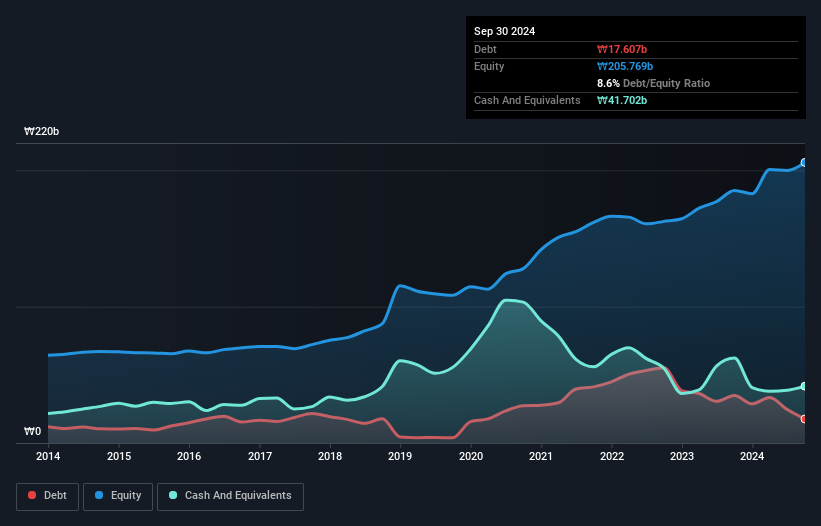Some say volatility, rather than debt, is the best way to think about risk as an investor, but Warren Buffett famously said that 'Volatility is far from synonymous with risk.' So it might be obvious that you need to consider debt, when you think about how risky any given stock is, because too much debt can sink a company. We note that Eyesvision Corp. (KOSDAQ:031310) does have debt on its balance sheet. But the real question is whether this debt is making the company risky.
What Risk Does Debt Bring?
Debt and other liabilities become risky for a business when it cannot easily fulfill those obligations, either with free cash flow or by raising capital at an attractive price. In the worst case scenario, a company can go bankrupt if it cannot pay its creditors. However, a more common (but still painful) scenario is that it has to raise new equity capital at a low price, thus permanently diluting shareholders. By replacing dilution, though, debt can be an extremely good tool for businesses that need capital to invest in growth at high rates of return. When we think about a company's use of debt, we first look at cash and debt together.
Check out our latest analysis for Eyesvision
How Much Debt Does Eyesvision Carry?
The image below, which you can click on for greater detail, shows that Eyesvision had debt of ₩17.6b at the end of September 2024, a reduction from ₩34.8b over a year. However, its balance sheet shows it holds ₩41.7b in cash, so it actually has ₩24.1b net cash.

A Look At Eyesvision's Liabilities
We can see from the most recent balance sheet that Eyesvision had liabilities of ₩39.6b falling due within a year, and liabilities of ₩7.41b due beyond that. On the other hand, it had cash of ₩41.7b and ₩22.8b worth of receivables due within a year. So it actually has ₩17.4b more liquid assets than total liabilities.
This luscious liquidity implies that Eyesvision's balance sheet is sturdy like a giant sequoia tree. Having regard to this fact, we think its balance sheet is as strong as an ox. Succinctly put, Eyesvision boasts net cash, so it's fair to say it does not have a heavy debt load! When analysing debt levels, the balance sheet is the obvious place to start. But it is Eyesvision's earnings that will influence how the balance sheet holds up in the future. So when considering debt, it's definitely worth looking at the earnings trend. Click here for an interactive snapshot.
In the last year Eyesvision had a loss before interest and tax, and actually shrunk its revenue by 7.3%, to ₩182b. We would much prefer see growth.
So How Risky Is Eyesvision?
Although Eyesvision had an earnings before interest and tax (EBIT) loss over the last twelve months, it made a statutory profit of ₩4.9b. So when you consider it has net cash, along with the statutory profit, the stock probably isn't as risky as it might seem, at least in the short term. We'll feel more comfortable with the stock once EBIT is positive, given the lacklustre revenue growth. There's no doubt that we learn most about debt from the balance sheet. But ultimately, every company can contain risks that exist outside of the balance sheet. For example, we've discovered 3 warning signs for Eyesvision that you should be aware of before investing here.
Of course, if you're the type of investor who prefers buying stocks without the burden of debt, then don't hesitate to discover our exclusive list of net cash growth stocks, today.
Valuation is complex, but we're here to simplify it.
Discover if Eyesvision might be undervalued or overvalued with our detailed analysis, featuring fair value estimates, potential risks, dividends, insider trades, and its financial condition.
Access Free AnalysisHave feedback on this article? Concerned about the content? Get in touch with us directly. Alternatively, email editorial-team (at) simplywallst.com.
This article by Simply Wall St is general in nature. We provide commentary based on historical data and analyst forecasts only using an unbiased methodology and our articles are not intended to be financial advice. It does not constitute a recommendation to buy or sell any stock, and does not take account of your objectives, or your financial situation. We aim to bring you long-term focused analysis driven by fundamental data. Note that our analysis may not factor in the latest price-sensitive company announcements or qualitative material. Simply Wall St has no position in any stocks mentioned.
About KOSDAQ:A031310
Eyesvision
Engages in the mobile business in South Korea and internationally.
Excellent balance sheet and fair value.
Market Insights
Community Narratives



